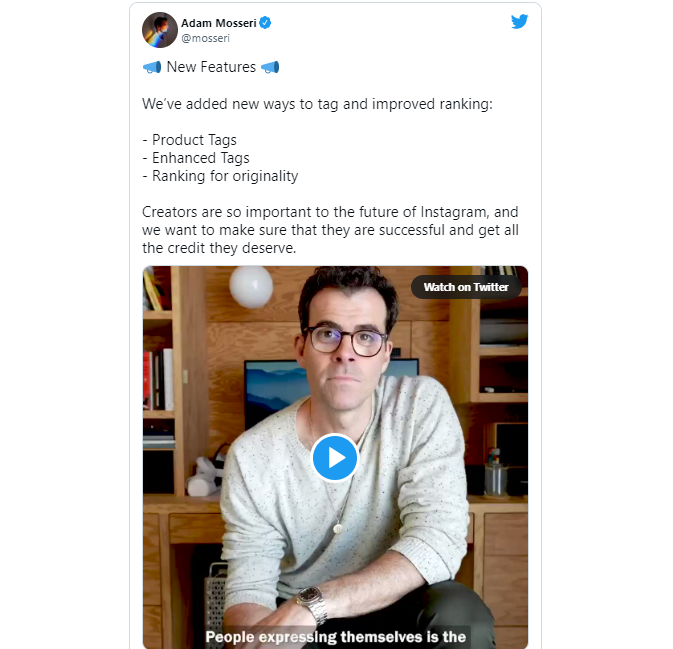In a move that could spark concern among some marketers, Instagram is moving to prioritise original content over reposts.
Marketers who lean into a lot of user-generated content, memes or even potentially influencer posts or have done so in the past could feel a pinch following Instagram’s latest algorithm updates.
In a video posted on Twitter, Instagram’s head explained the move.
Adam Mosseri, Head of Instagram, via Twitter
“If you create something from scratch, you should get more credit than if you are resharing something that you found from someone else. [As such] we’re going to do more to try and value original content more, particularly compared to reposted content.”
As Mosseri said, Instagram is making the change to provide original creators with more value from their work. As a result, big content aggregators will likely see a drop in engagement as they often focus on reposting media.
The new algorithm is less likely to recommend reposts of Reels, and it will focus on recommending original content. It wants to be a place where original creators are rewarded with growth, engagement and revenue. Of course, if Insta can lure more creatives to the app (and from rivals like TikTok), it can boost its popularity with users.
And brands will always be open to putting money and time into a platform if there’s a higher chance of forging successful partnerships with influencers that boost revenue and brand awareness.
Adam Mosseri, Head of Instagram, via Twitter
“As we lean more into recommendations it’s becoming increasingly important that we don’t overvalue aggregators, as that would be bad for creators, and therefore bad for Instagram long term.”
A learning curve for the machine
How Instagram defines original content is important. For this update, as long as you have made it, it’s original. That means that if you’ve edited your video outside of Instagram and uploaded it via the gallery, it will be classed as original.
Mosseri did admit that it will be difficult for the platform to get this right every time and that the algorithm will learn and improve over time – so be prepared to have some frustrating moments over the next few months.
The app will build classifiers to predict how likely something is to be original, meaning posting history will play a big part in the machine’s thinking.
Where this starts to get a bit sticky is with plagiarised content. If a user posts a video as their own, when it’s not, it could still pass the classifiers’ likelihood’ checks. To determine originality, Mosseri explained that it would look at factors such as who is in the video and if Instagram has seen the video before.
Learning from history
The change will particularly affect big meme accounts that repost tons of content and generate millions of likes and comments. Many of which are very popular for brand collaborations.
Adam Mosseri, Head of Instagram, via Twitter
“If the account is an aggregator, we’ll more likely be able to detect that it’s not original.”
There could be another impact for brands: user-generated content (UGC) could now be marked down. According to Mosseri, if you’re posting content that has already been shared on Instagram, it’s less likely to be recommended by the algorithm.
However, if you can stomach a reduction in reach because UGC is so good for engaging with your community, then that’s something you might just have to endure.
Mosseri didn’t mention the impacts of posting UGC to Stories – nor did he say how this would affect its new Collabs feature. Collabs allow brands to invite another account to collaborate on a Post or Reel, which appears with both handles on the post and is shown on both parties’ feeds.
As this is a new feature, you can see that Instagram would throw its baby out with the bathwater. If you use partnerships, maybe play it safe for now and stick with Collabs.
Although alas, the recent Collabs feature is also quite heavily misused, with brands incorrectly using it in place of Branded Content tags when working with talent.
What a minefield…
Tagging tidbits
Speaking of tags, Mosseri also spilt the beans on updates to product tags.
Product tags are now available to all U.S users with a public account. It was previously restricted to just creators and brands.
The extension is designed to make it earlier for all users to recommend products from people they follow – while it will help businesses to reach and sell to online audiences.
Enhanced tags are designed to make sure creators receive appropriate credit for their work. It will let users share and see a creator’s specific contribution to the post. Brands can use these to give everyone who contributed to a piece of content the exposure they deserve.
Enhanced tags provide appropriate credit to everyone who deserves it, while product tags increase the chance that you’ll manage to increase your e-commerce footprint on the app.
But for users outsides of the U.S., all you can do is get your ducks in a line before product tags hit your shores.
*Image via Etienne Girardet at Unsplash.




RECOMMENDED FOR YOU
[STUDY] ChatGPT Powers Work And Life
OpenAI, in collaboration with Harvard economist David Deming, has…
OpenAI, in collaboration with Harvard economist David Deming, has…
LinkedIn Tests New Premium Tools for SMBs
LinkedIn is quietly piloting a new Premium offering designed…
LinkedIn is quietly piloting a new Premium offering designed…
Instagram Finally Adds Reposts and Maps
Instagram has officially rolled out three new features that…
Instagram has officially rolled out three new features that…